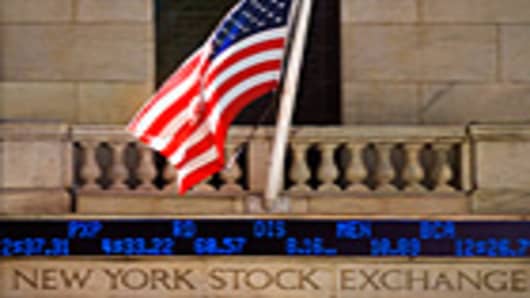Stocks around the world have been struggling lately, but one group of equities may ultimately benefit from all the fear and uncertainty: so-called megacaps.
Ever since worries over the European debt crisis began to escalate more than a year and a half ago, the biggest American blue-chip stocks have been among the few bright spots for investors.
Since the start of last year, the Russell Top 50 index of the largest-capitalization domestic stocks has climbed more than 14 percent, while the MSCI EAFE index of foreign equities has sunk more than 15 percent and the Russell 2000 index of small-company shares has gained just 1 percent. Tack on dividends and megacap stocks have returned more than 18 percent during a period of heightened volatility and fear on Wall Street.
These giant stocks, with a market capitalization of around $50 billion or higher, managed to avoid losses in what’s been a tough month for many smaller stocks. The megacaps are up around 2 percent in July, while small-cap stocks are off nearly 1 percent.
Because of their size and industry dominance, megacaps have traditionally been seen as a relatively stable spot for equity investors. But their recent outperformance was a notable turnaround for a group that had generally been out of favor since the late 1990s, when shares of giant companies like Microsoft and Cisco Systems dominated the market before the growth stock bubble burst in 2000.
Some strategists say this could be an early sign of the market’s gradual shift back toward big stocks after years of favoring small-company and even international equities.
“Large caps may finally be having their day in the sun,” said Jack A. Ablin, chief investment officer at Harris Private Bank.
Mr. Ablin added that while equities are still slogging through a rough patch, a number of factors are weighing in the favor of large-cap stocks in general right now. “One is their stability,” he said, “but there’s also their dividends.”
The 50 megacap stocks, most of which pay dividends, have an average yield of 2.2 percent, which compares favorably with the 1.6 percent average payout of small-company stocks and the 1.5 percent yield on 10-year Treasury notes.
The recent turmoil in Europe may be indirectly helping the megacaps in other ways. For starters, as global investors have been fleeing the euro, they’ve been driving money into dollar-denominated assets like Treasuries. That has bolstered the value of the dollar, which is up 13 percent since April 2011.
“Basically, people have been looking to escape Europe, and those who want to keep their money in equities are probably seeking the safer shores of megacaps in the United States,” said Sam Stovall, chief equity strategist at S.& P. Capital IQ.
The strengthening dollar has also focused American investors’ attention back on the domestic market. When the dollar was falling for much of the last decade, Americans could make money on their foreign investments simply through the currency fluctuation.
From January 2002 to April 2011, the dollar lost 39 percent of its value against a basket of foreign currencies. During that stretch, European stocks sank 6.5 percent when measured in the local currency. But because of the sinking dollar, Americans actually saw their European shares soar 61 percent.
Now that the dollar has reversed course and is gaining ground, American investors have less desire to invest abroad and more reason to keep their money in domestic shares.
But aren’t megacap stocks also exposed to foreign markets?
Yes. The average large company generates more than 46 percent of its revenue abroad, versus just 31 percent for small companies, according to S.& P.
Yet megacaps have generally done well anyway. “Bigger businesses, in particular since the financial crisis, have clearly proven to be more adaptable than a lot of people thought,” said Keith Trauner, co-portfolio manager of the GoodHaven Fund, which invests in a mix of big and small stocks. “They’ve been able to reduce costs and adjust their expense structure better than most people would have imagined.”
Mr. Trauner’s fund has beaten 75 percent of its peers in the last year, thanks in part to big stakes in megacaps like Microsoft and Wal-Mart. He added that some investors were probably still overlooking this group because many megacaps were “dead money” for more than a decade.
From 2000 through 2010, for instance, Microsoft lost 4.6 percent while Wal-Mart sank 1 percent, both annualized.
Wallace Weitz, president of the Weitz Funds, said, “I’ve been doing this for more than 40 years, yet it still surprises me that people look away from good companies because they ‘haven’t done anything’ for a long time.”
That’s exactly where value-minded investors ought to be looking for attractively priced shares, he said.
MEGACAP stocks, which in 2000 had a frothy price-to-earnings ratio of 33, are now trading at 13 times estimated earnings. By comparison, shares of medium-size companies have an average P/E ratio of 16, while the figure for small companies is nearly 20.
“It’s a question of what risk you want to take,” said Pat W. Dorsey, president and director of research and strategy at Sanibel Captiva Investment Advisers. Investors fearful of stocks with any European exposure may be wary of megacaps. But in such times, skittish investors are also prone to punish stocks with high P/E ratios.
Mr. Dorsey says many megacap are cheaply priced — and they appeal to him. “I would prefer to take less valuation risk,” he said.


